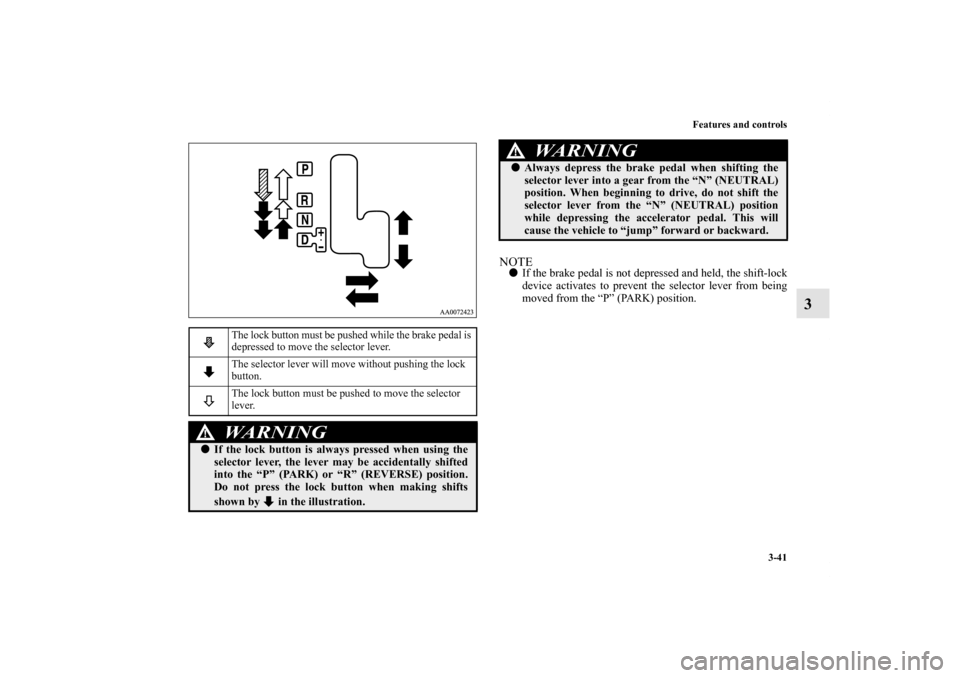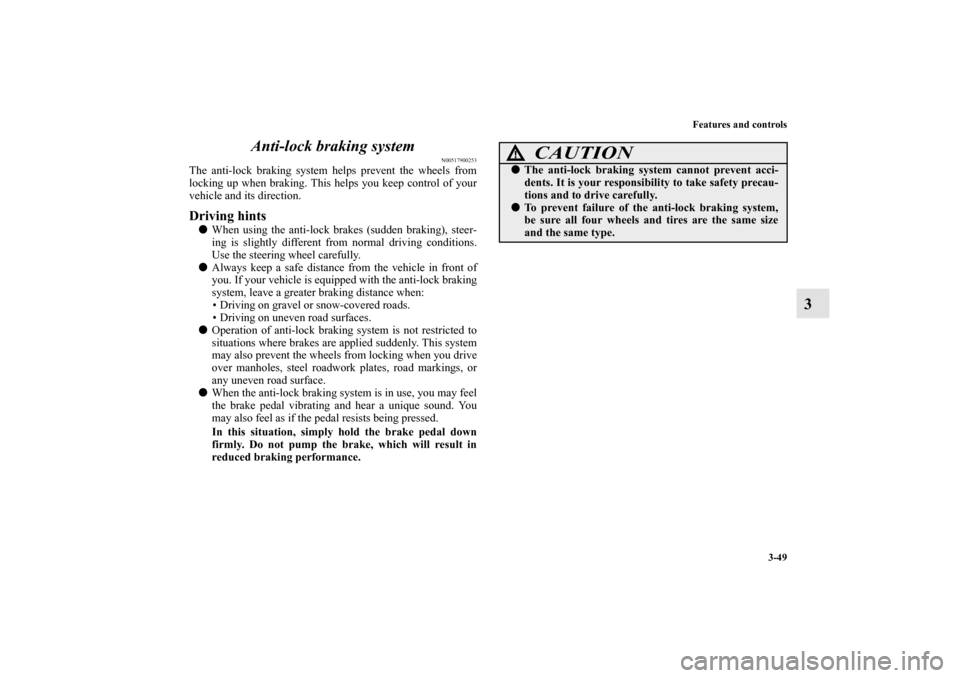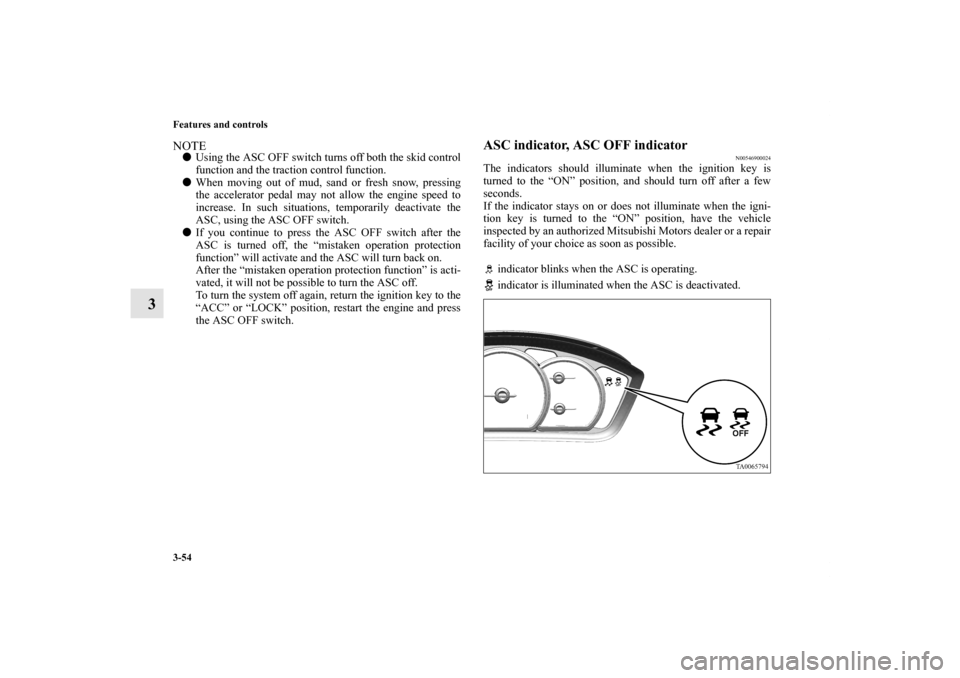Page 129 of 424
3-40 Features and controls
3
The transaxle has 4 forward gears and 1 reverse gear.
The individual gears are selected automatically, depending on
the position of the gear selector lever, the speed of the vehicle
and the position of the accelerator pedal.
The selector lever has 2 “gates”: the main gate (A) and the
manual gate (B). NOTE�For information on manual gate operation, refer to “Sports
mode” on page 3-44.In the main gate, the selector lever has 4 positions, and is
equipped with a lock button (A) to prevent inadvertent selec-
tion of the wrong gear.
BK0121200US.book 40 ページ 2010年4月14日 水曜日 午前11時24分
Page 130 of 424

Features and controls
3-41
3
NOTE�If the brake pedal is not depressed and held, the shift-lock
device activates to prevent the selector lever from being
moved from the “P” (PARK) position.
The lock button must be pushed while the brake pedal is
depressed to move the selector lever.
The selector lever will move without pushing the lock
button.
The lock button must be pushed to move the selector
lever. WA R N I N G
!�If the lock button is always pressed when using the
selector lever, the lever may be accidentally shifted
into the “P” (PARK) or “R” (REVERSE) position.
Do not press the lock button when making shifts
shown by in the illustration.
�Always depress the brake pedal when shifting the
selector lever into a gear from the “N” (NEUTRAL)
position. When beginning to drive, do not shift the
selector lever from the “N” (NEUTRAL) position
while depressing the accelerator pedal. This will
cause the vehicle to “jump” forward or backward.
WA R N I N G
!
BK0121200US.book 41 ページ 2010年4月14日 水曜日 午前11時24分
Page 132 of 424

Features and controls
3-43
3
Selector lever positions
N00514200268
“P” PARKThis position locks the transaxle to prevent the vehicle from
moving. The engine can be started from the “PARK” position.“R” REVERSEMove the lever to this position only after the vehicle has come
to a complete stop.
“N” NEUTRALAt this position, the transaxle is disengaged. It is the same as
the neutral position on a manual transaxle and should be used
when the vehicle is not moving for an extended length of time
during driving, such as in a traffic jam.“D” DRIVEThis position is used for most city and highway driving. Engine
shifting and braking are done automatically as needed, depend-
ing on road conditions.NOTE�For information on manual gate operation, please refer to
“Sports mode” on page 3-44.
CAUTION
!�Never shift into the “P” (PARK) or “R”
(REVERSE) position while the vehicle is in motion.
If the lever is shifted into the “P” (PARK) or “R”
(REVERSE) position while the vehicle is in motion,
the transaxle may be damaged.
WA R N I N G
!�Never move the selector lever to the “N” (NEU-
TRAL) position while driving since you could acci-
dentally slip it into the “P” (PARK) or
“R”(REVERSE) position, damaging the transaxle.�To prevent the vehicle from rolling when stopped on
a slope, the engine should be started in the “P”
(PARK) position, not in “N” (NEUTRAL).�Always keep your foot on the brake pedal when the
vehicle is in “N” (NEUTRAL), or when shifting into
or out of “N” (NEUTRAL), to prevent rolling.
BK0121200US.book 43 ページ 2010年4月14日 水曜日 午前11時24分
Page 138 of 424

Features and controls
3-49
3 Anti-lock braking system
N00517900253
The anti-lock braking system helps prevent the wheels from
locking up when braking. This helps you keep control of your
vehicle and its direction. Driving hints �When using the anti-lock brakes (sudden braking), steer-
ing is slightly different from normal driving conditions.
Use the steering wheel carefully.
�Always keep a safe distance from the vehicle in front of
you. If your vehicle is equipped with the anti-lock braking
system, leave a greater braking distance when:
• Driving on gravel or snow-covered roads.
• Driving on uneven road surfaces.
�Operation of anti-lock braking system is not restricted to
situations where brakes are applied suddenly. This system
may also prevent the wheels from locking when you drive
over manholes, steel roadwork plates, road markings, or
any uneven road surface.
�When the anti-lock braking system is in use, you may feel
the brake pedal vibrating and hear a unique sound. You
may also feel as if the pedal resists being pressed.
In this situation, simply hold the brake pedal down
firmly. Do not pump the brake, which will result in
reduced braking performance.
CAUTION
!�The anti-lock braking system cannot prevent acci-
dents. It is your responsibility to take safety precau-
tions and to drive carefully. �To prevent failure of the anti-lock braking system,
be sure all four wheels and tires are the same size
and the same type.
BK0121200US.book 49 ページ 2010年4月14日 水曜日 午前11時24分
Page 139 of 424

3-50 Features and controls
3
Anti-lock braking system warning light
N00531600427
This light comes on in the event of a malfunction in the anti-
lock braking system. It will also come on as a self-check for a
few seconds when the ignition key is turned to the “ON” posi-
tion. Always make sure that the light goes out before beginning
to drive.
If the warning light illuminates while driving
N00531700369
�Since there is always a risk of your vehicle becoming
unstable if you apply the brakes suddenly, be sure to brake
gently and do not attempt high-speed driving. Be sure to
stop the vehicle in a safe place. Test the system by restart-
ing the engine and driving at a speed of about 12 mph
(20 km/h) or higher.
�If the light goes out, there is no abnormal condition. If the
light does not go out after driving as instructed here, or if
it comes on again, the anti-lock braking system is not
functioning. Only the ordinary braking system is function-
ing. If this happens, take your vehicle to an authorized
Mitsubishi Motors dealer or a repair facility of your
choice and have the system checked as soon as possible.NOTE�After your vehicle is driven a short distance after starting
the engine, you will hear a whining sound and the sound
of a motor operating coming from the engine compart-
ment. These are the normal sounds the anti-lock braking
system makes when performing a self-check. It does not
indicate a malfunction.
�The anti-lock braking system can be used after the vehicle
has reached a speed over approximately 6 mph (10 km/h).
It stops working when the vehicle slows below approxi-
mately 3 mph (5 km/h).
�After driving on snow or icy roads, remove any snow and
ice which may have been left around the wheels. On vehi-
cles that have an anti-lock braking system, be careful not
to damage the wheel speed sensors (A) or the cables
located at each wheel.
CAUTION
!�If the anti-lock braking system warning light comes
on and stays on after starting the engine or while
driving, it means that the anti-lock braking system is
not working and that only the standard brake sys-
tem is available. (The standard brake system will
still work properly.) If this happens, take your vehi-
cle to an authorized Mitsubishi Motors dealer or a
repair facility of your choice as soon as possible.
or
BK0121200US.book 50 ページ 2010年4月14日 水曜日 午前11時24分
Page 140 of 424

Features and controls
3-51
3 Active stability control (ASC)
N00559100088
The active stability control (ASC) takes overall control of the
anti-lock braking system, traction control function and skid
control function to help maintain the vehicle’s control and trac-
tion. Also refer to the following pages on the anti-lock braking
system, traction control function and skid control function.
Anti-lock braking system (ABS) → P. 3 - 4 9
Traction control function → P. 3 - 5 2
Skid control function → P. 3 - 5 3
FrontRear
CAUTION
!�Do not over-rely on the ASC. Even the ASC cannot
prevent the natural laws of physics from acting on
the vehicle. This system, like any other system, has
limits and cannot help you to maintain traction and
control of the vehicle in all circumstances. Reckless
driving can lead to accidents. It is the driver’s
responsibility to drive carefully. This means taking
into account the traffic, road and environmental
conditions.�Be sure to use the same specified type and size of tire
on all four wheels. Otherwise, the ASC may not
work properly.�Do not install any aftermarket limited slip differen-
tial (LSD) on your vehicle. The ASC may stop func-
tioning properly.
BK0121200US.book 51 ページ 2010年4月14日 水曜日 午前11時24分
Page 141 of 424

3-52 Features and controls
3
NOTE�A whining sound may be heard from the engine compart-
ment in the following situations. The sound is associated
with the ASC self-check operations. It does not indicate a
malfunction.
• When the ignition key is set to the “ON” position.
• When the vehicle is driven for a while after the engine is
turned on.
�When the ASC is activated, you may feel a vibration in
the vehicle body or hear a whining sound from the engine
compartment.
This indicates that the system is operating normally. It
does not indicate a malfunction.
�When the anti-lock braking system warning light is illu-
minated, the ASC is not active.
Traction control function
N00559200063
On slippery surfaces, the traction control function prevents the
drive wheels from spinning excessively, thus helping the vehi-
cle to start moving from a stopped condition. It also provides
sufficient driving force and steering performance as the vehicle
turns while pressing the acceleration pedal.
CAUTION
!�When driving a vehicle on a snowy or icy road, be
sure to install snow tires and drive the vehicle at
moderate speeds.
BK0121200US.book 52 ページ 2010年4月14日 水曜日 午前11時24分
Page 143 of 424

3-54 Features and controls
3
NOTE�Using the ASC OFF switch turns off both the skid control
function and the traction control function.
�When moving out of mud, sand or fresh snow, pressing
the accelerator pedal may not allow the engine speed to
increase. In such situations, temporarily deactivate the
ASC, using the ASC OFF switch.
�If you continue to press the ASC OFF switch after the
ASC is turned off, the “mistaken operation protection
function” will activate and the ASC will turn back on.
After the “mistaken operation protection function” is acti-
vated, it will not be possible to turn the ASC off.
To turn the system off again, return the ignition key to the
“ACC” or “LOCK” position, restart the engine and press
the ASC OFF switch.
ASC indicator, ASC OFF indicator
N00546900024
The indicators should illuminate when the ignition key is
turned to the “ON” position, and should turn off after a few
seconds.
If the indicator stays on or does not illuminate when the igni-
tion key is turned to the “ON” position, have the vehicle
inspected by an authorized Mitsubishi Motors dealer or a repair
facility of your choice as soon as possible.
indicator blinks when the ASC is operating.
indicator is illuminated when the ASC is deactivated.
BK0121200US.book 54 ページ 2010年4月14日 水曜日 午前11時24分